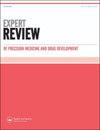PD-L1 assessment in breast cancer immunotherapy: a critical overview
IF 1.2
Q4 PHARMACOLOGY & PHARMACY
Expert Review of Precision Medicine and Drug Development
Pub Date : 2022-01-02
DOI:10.1080/23808993.2022.2094766
引用次数: 0
Abstract
The advent of immune checkpoint inhibitors (ICIs) has recently made a breakthrough in several hematological and solid tumors including, among others, non-small-cell lung cancer, renal cell carcinoma, melanoma, urothelial carcinoma, and hepatocellular carcinoma [1–3]. These agents are able to enhance antitumor activity, leading to an increase in the cytotoxicity of T cells and the blocking of downregulators of immunity such as programmed cell death protein 1 (PD-1) and its ligand PD-L1, cytotoxic T-lymphocyte antigen 4 (CTLA-4), and lymphocyte activating-3 (LAG-3) [4]. ICIs have also been recently assessed in breast cancer (BC), as monotherapy or in combination with other anticancer agents. First, monotherapy with ICIs has reported disappointing results in unselected triple-negative BC (TNBC), with approximately one-quarter of patients achieving response [5]; in fact, the KEYNOTE-086 and the KEYNOTE-119 trials evaluating pembrolizumab monotherapy highlighted response rates lower than 10%, and these findings have also been confirmed by clinical studies evaluating other immunotherapies, such as single-agent atezolizumab [6]. Thus, several combination treatments have been investigated, based on the synergistic effect of ICIs plus other anticancer agents with different mechanism of action. Among these combinatorial strategies, and following the results of landmark trials, chemoimmunotherapy has entered into clinical practice as new front-line treatment in TNBC patients with metastatic disease and PD-L1 overexpression or elevated combined positive score (CPS) [7]. Moreover, a large number of phase I to III clinical trials are assessing immunebased combinations, with these studies having the potential to further shape the direction of firstand later-line therapy in this patient population. However, a high unmet need in BC immunotherapy remains the lack of biomarkers predictive of response to ICIs. In fact, if PD-L1 is considered the most reliable predictor, its assessment presents several limitations, and it is far from being standardized [8]. The expression of PD-L1 is typically detected on tumor cells (TC) or immune cells (IC), and in recent years, PD-L1 assessment has emerged as an important predictive biomarker of response to immunotherapy in several tumor types (e.g. nonsmall-cell lung cancer, head and neck cancer, and gastric cancer) [9,10]. As regards BC, PD-L1 status has been associated with a prognostic value, and high PD-L1 expression seems to predict worse clinical outcomes in triple-negative BC patients [11]. PD-L1 has been validated as a predictor of response to chemoimmunotherapy in metastatic BC and has entered into everyday clinical practice, following the results of recently published IMpassion130 and KEYNOTE-355 phase III clinical trials [12,13]. The IMpassion130 compared chemoimmunotherapy with atezolizumab–nab-paclitaxel versus placebo plus nabpaclitaxel as front-line treatment in TNBC patients with metastatic disease [12]; the coprimary endpoints were progressionfree survival (PFS) and overall survival (OS) in the intention-totreat (ITT) and in PD-L1-positive patients, with PD-L1 expression determined on IC and centrally evaluated per VENTANA SP142 immunohistochemistry assay (positive in the case of IC ≥1% and negative with IC <1%) [12]. The IMpassion130 highlighted a statistically superior and clinically meaningful benefit in terms of OS in patients with PD-L1 expression ≥1% receiving chemoimmunotherapy, leading to the approval of atezolizumab–nab-paclitaxel in this setting [12]. Similarly, the KEYNOTE-355 highlighted longer PFS and OS in metastatic TNBC patients with PD-L1 CPS ≥10 treated with pembrolizumab–chemotherapy versus placebo–chemotherapy [13]. In another study in the neoadjuvant setting, the KEYNOTE-522, the authors observed that in patients with early triple-negative breast cancer, neoadjuvant pembrolizumab plus chemotherapy, followed by adjuvant pembrolizumab after surgery, resulted in significantly longer event-free survival than neoadjuvant chemotherapy alone, regardless of PD-L1 status [14]. Despite these trials have recently had an important impact in BC clinical practice worldwide, some fundamental issues regarding PD-L1 assessment should be highlighted. First, recent studies have suggested differences in terms of PD-L1 status according to primary tumors and secondary lesions in BC patients [15]. For example, a retrospective trial conducted by Rozenblit et al. compared PD-L1 expression between primary tumors (n = 179) and metastatic sites (n = 161) [15]. Interestingly, the authors reported higher PD-L1 expression in primary cancers compared with secondary lesions (63.7% versus 42.2%, respectively) by using the SP142 antibody [15]; in addi-PD-L1在乳腺癌免疫治疗中的评估:一个关键的概述
免疫检查点抑制剂(ici)的出现最近在几种血液学和实体肿瘤中取得了突破,其中包括非小细胞肺癌、肾细胞癌、黑色素瘤、尿路上皮癌和肝细胞癌[1-3]。这些药物能够增强抗肿瘤活性,导致T细胞的细胞毒性增加,并阻断免疫下调因子,如程序性细胞死亡蛋白1 (PD-1)及其配体PD-L1、细胞毒性T淋巴细胞抗原4 (CTLA-4)和淋巴细胞活化-3 (LAG-3)[4]。ICIs最近也被评估用于乳腺癌(BC),作为单一治疗或与其他抗癌药物联合使用。首先,据报道,ICIs单药治疗未选择的三阴性BC (TNBC)的结果令人失望,大约四分之一的患者达到了[5];事实上,评估派姆单抗单药治疗的KEYNOTE-086和KEYNOTE-119试验强调反应率低于10%,这些发现也得到了评估其他免疫疗法的临床研究的证实,如单药atezolizumab[6]。因此,基于ICIs与其他具有不同作用机制的抗癌药物的协同作用,研究了几种联合治疗方法。在这些组合策略中,随着具有里程碑意义的试验的结果,化学免疫疗法已作为新的一线治疗方法进入临床实践,用于转移性疾病、PD-L1过表达或联合阳性评分(CPS)[7]升高的TNBC患者。此外,大量的I - III期临床试验正在评估基于免疫的联合治疗,这些研究有可能进一步塑造这一患者群体的一线后期治疗方向。然而,对BC免疫治疗的高度未满足的需求仍然缺乏预测对ICIs反应的生物标志物。事实上,如果PD-L1被认为是最可靠的预测因子,其评估存在一些局限性,而且还远未标准化。PD-L1的表达通常在肿瘤细胞(TC)或免疫细胞(IC)上检测,近年来,PD-L1的评估已成为几种肿瘤类型(如非小细胞肺癌、头颈癌和胃癌)对免疫治疗反应的重要预测生物标志物[9,10]。至于BC, PD-L1状态与预后价值相关,在三阴性BC患者中,高PD-L1表达似乎预示着更差的临床结果。根据最近发表的IMpassion130和KEYNOTE-355 III期临床试验的结果,PD-L1已被证实是转移性BC对化学免疫治疗反应的预测因子,并已进入日常临床实践[12,13]。IMpassion130比较了atzolizumab - nab-紫杉醇化疗免疫治疗与安慰剂加纳紫杉醇作为TNBC转移性疾病患者的一线治疗;主要终点是意向治疗(ITT)患者和PD-L1阳性患者的无进展生存期(PFS)和总生存期(OS), PD-L1表达通过IC检测,并通过VENTANA SP142免疫组织化学方法进行集中评估(IC≥1%为阳性,IC <1%为阴性)[12]。IMpassion130强调,在接受化疗免疫治疗的PD-L1表达≥1%的患者的OS方面,有统计学上的优势和临床意义的益处,导致atezolizumab - nab-紫杉醇在这一背景下获得批准。同样,KEYNOTE-355强调,PD-L1 CPS≥10的转移性TNBC患者接受派姆单抗化疗比安慰剂化疗[13]的PFS和OS更长。在另一项关于新辅助治疗的研究KEYNOTE-522中,作者观察到,在早期三阴性乳腺癌患者中,无论PD-L1状态如何,新辅助派姆单抗加化疗,术后再加辅助派姆单抗,比单独新辅助化疗的无事件生存期明显更长。尽管这些试验最近在世界范围内的BC临床实践中产生了重要影响,但应该强调一些关于PD-L1评估的基本问题。首先,最近的研究表明,根据BC患者的原发肿瘤和继发病变,PD-L1状态存在差异。例如,Rozenblit等人进行的一项回顾性试验比较了原发肿瘤(n = 179)和转移部位(n = 161)的PD-L1表达。有趣的是,通过使用SP142抗体[15],作者报告了原发性癌症中PD-L1的表达高于继发性病变(分别为63.7%和42.2%);在另外
本文章由计算机程序翻译,如有差异,请以英文原文为准。
求助全文
约1分钟内获得全文
求助全文
来源期刊

Expert Review of Precision Medicine and Drug Development
PHARMACOLOGY & PHARMACY-
CiteScore
2.30
自引率
0.00%
发文量
9
期刊介绍:
Expert Review of Precision Medicine and Drug Development publishes primarily review articles covering the development and clinical application of medicine to be used in a personalized therapy setting; in addition, the journal also publishes original research and commentary-style articles. In an era where medicine is recognizing that a one-size-fits-all approach is not always appropriate, it has become necessary to identify patients responsive to treatments and treat patient populations using a tailored approach. Areas covered include: Development and application of drugs targeted to specific genotypes and populations, as well as advanced diagnostic technologies and significant biomarkers that aid in this. Clinical trials and case studies within personalized therapy and drug development. Screening, prediction and prevention of disease, prediction of adverse events, treatment monitoring, effects of metabolomics and microbiomics on treatment. Secondary population research, genome-wide association studies, disease–gene association studies, personal genome technologies. Ethical and cost–benefit issues, the impact to healthcare and business infrastructure, and regulatory issues.
 求助内容:
求助内容: 应助结果提醒方式:
应助结果提醒方式:


